The Shire Countryside (3R113)
Back to Realms of the Elf-Lords Index |
Three Monstrous Trolls (3C114) |
The Shire Countryside (3R113) is a Shire Condition from the Realms of the Elf-Lords set. While not particularly noteworthy upon its release, later cards empowered it to become one of the most notorious Free Peoples conditions. This posed a particular problem for Decipher: they had few ways to create new sources of burden removal without continuing to propel The Shire Countryside to greater heights and no way to use a companion's vitality to reliably limit phase actions. Erland, Dale Counselor (11R30)
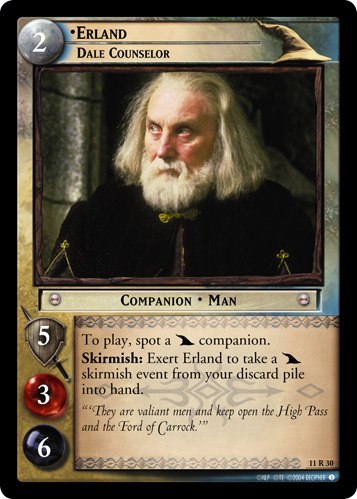 was the final straw,[1] a generally well-costed card that would introduce an endless loop with The Shire Countryside and A Light in His Mind (10U108)
was the final straw,[1] a generally well-costed card that would introduce an endless loop with The Shire Countryside and A Light in His Mind (10U108)
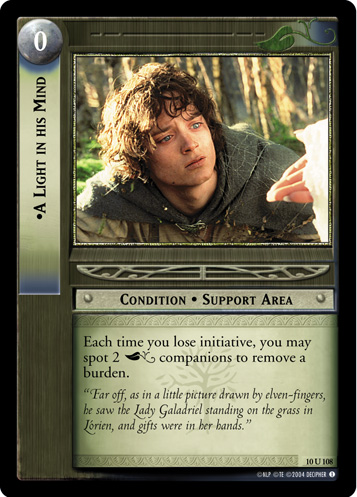 . It was one of many Fellowship Block cards to be banned when Shadows was released, a precursor to set rotation in Black Rider.
. It was one of many Fellowship Block cards to be banned when Shadows was released, a precursor to set rotation in Black Rider.
| ||||||||||||||||||||
| ||||||||||||||||||||
| ||||||||||||||||||||
Strategy[edit]
Gameplay Strategy[edit]
In Fellowship Block The Shire Countryside was a relatively unimpressive card. It required a relatively large stockpile of burdens from bidding (only Power According to His Stature (1R308)
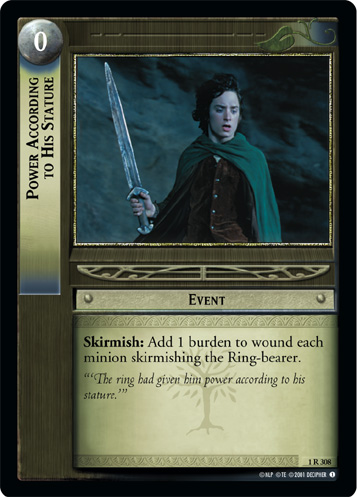 , Eregion Hills (3U116)
, Eregion Hills (3U116)
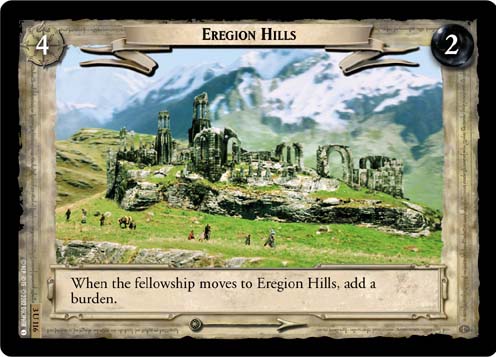 , or putting Frodo in situations to be wounded could reliably add burdens), which could put players in danger from Úlairë Enquëa, Lieutenant of Morgul (1U231)
, or putting Frodo in situations to be wounded could reliably add burdens), which could put players in danger from Úlairë Enquëa, Lieutenant of Morgul (1U231)
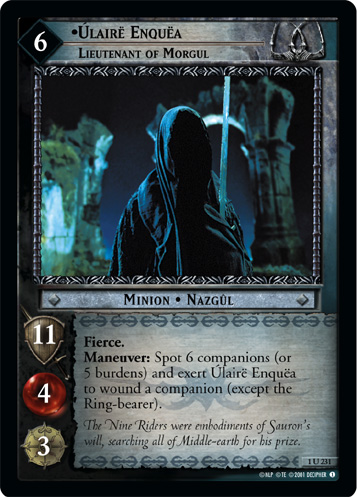 and Úlairë Toldëa, Messenger of Morgul (1R236)
and Úlairë Toldëa, Messenger of Morgul (1R236)
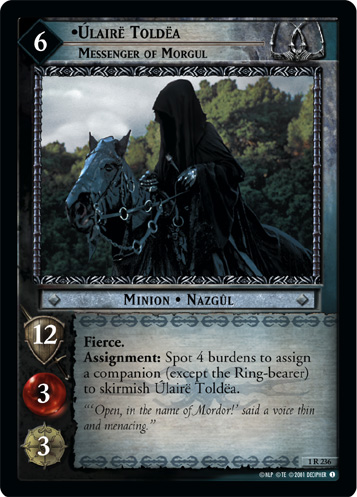 . Only a handful of cards could remove burdens, and while in conjunction with Gandalf’s Pipe (1U74)
. Only a handful of cards could remove burdens, and while in conjunction with Gandalf’s Pipe (1U74)
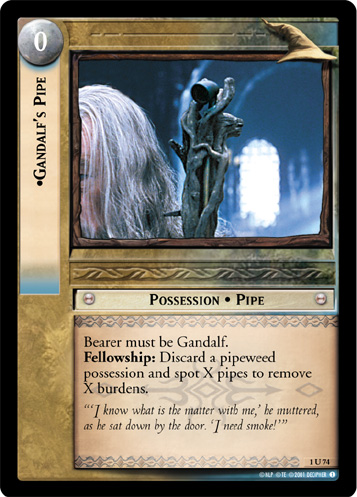 it produces downright obscene healing, that deck already has Aragorn’s Pipe (1U91)
it produces downright obscene healing, that deck already has Aragorn’s Pipe (1U91)
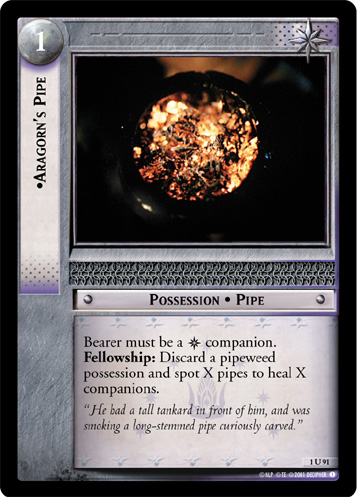 and is generally weakened by adding conditions to the mix. It's not that The Shire Countryside wasn't strong, it's just that all the preparation tended to overshadow the results. In Fellowship Block, it is most notable for a quirky combo with Stout and Sturdy (1C315)
and is generally weakened by adding conditions to the mix. It's not that The Shire Countryside wasn't strong, it's just that all the preparation tended to overshadow the results. In Fellowship Block, it is most notable for a quirky combo with Stout and Sturdy (1C315)
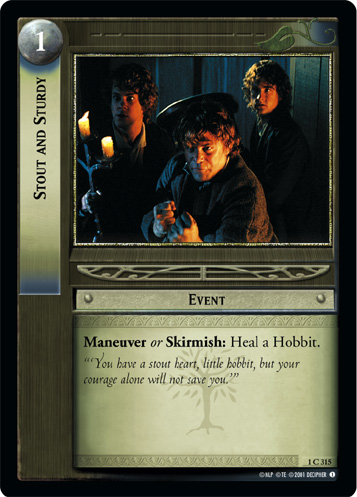 + Extraordinary Resilience (1C287)
+ Extraordinary Resilience (1C287)
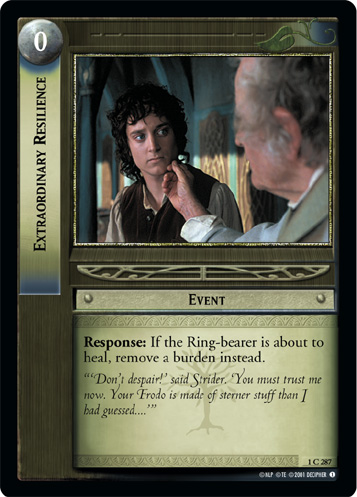 (or sometimes Songs of the Blessed Realm (1C61)
(or sometimes Songs of the Blessed Realm (1C61)
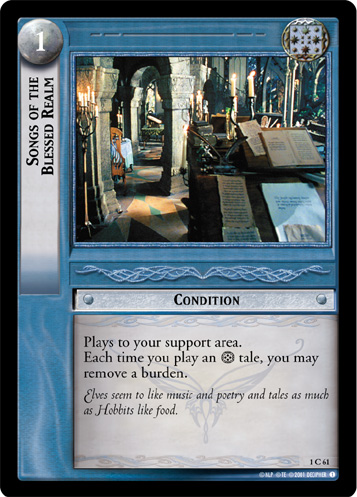 + Voice of Nimrodel (3C28)
+ Voice of Nimrodel (3C28)
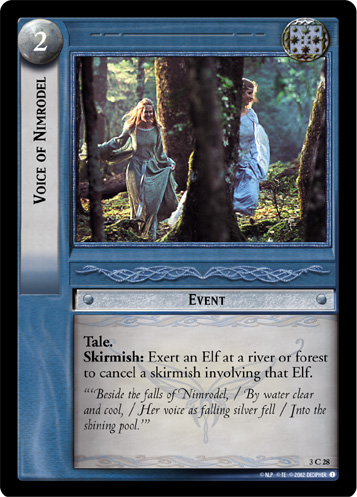 ) to heal Boromir, Son of Denethor (1U97)
) to heal Boromir, Son of Denethor (1U97)
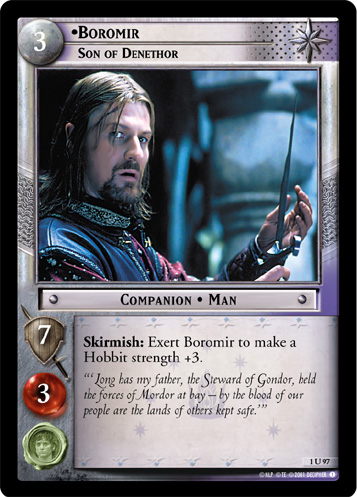 and Merry, Friend to Sam (1R302)
and Merry, Friend to Sam (1R302)
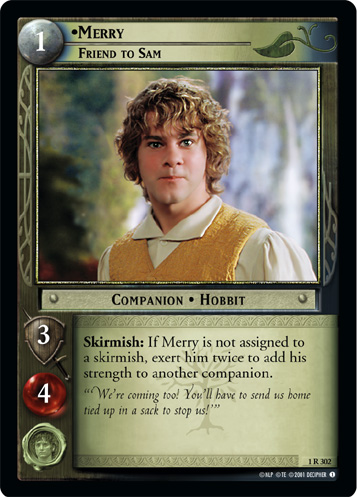 in the middle of a skirmish to apply their bonuses several times: a deck which aims to produce the highest strength level achievable rather than necessarily win the match.
in the middle of a skirmish to apply their bonuses several times: a deck which aims to produce the highest strength level achievable rather than necessarily win the match.
This changed in The Two Towers when two important things were made available: more and easier ways to remove burdens, and (perhaps less obviously) reliable ways for the Free Peoples to add them as needed. With the Free Peoples player controlling both the supply and demand of burdens, The Shire Countryside immediately went from quirky combo piece to serious asset. The key to its power is not just that it provides among the greatest healing potential in the game, but that it offers this at any time -- particularly useful for skirmish phases, when healing is scarce and many actions are otherwise constrained by companion vitality. Strategies built on exerting characters in skirmish phases benefit the most, but archery and maneuver phase exertions can also be undone in preparation for a double move. In fact, the healing made available by The Shire Countryside often has players actively looking for ways to exert their companions to keep the effect from going to waste.
Perhaps the most notorious deck for The Shire Countryside in Towers Standard is Sméagol, Slinker (5R29)
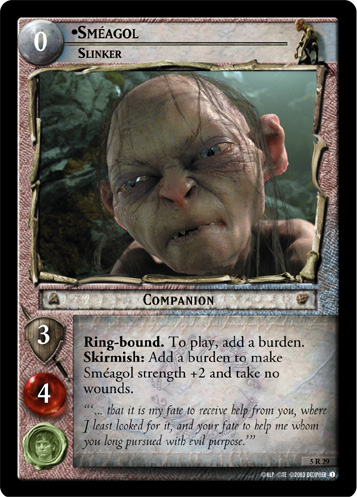 , Sting, Baggins Heirloom (5R116)
, Sting, Baggins Heirloom (5R116)
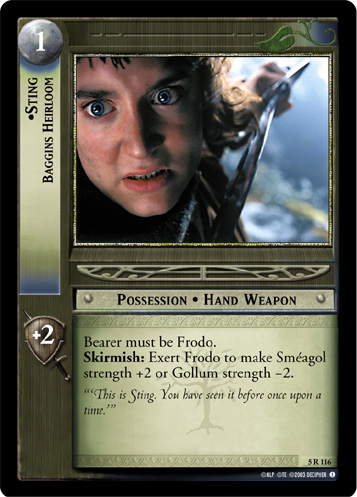 , and Not Listening (6C43)
, and Not Listening (6C43)
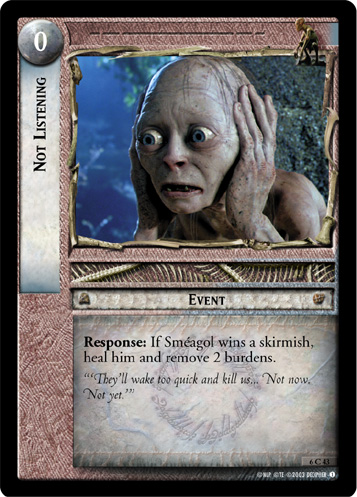 , further supplemented by Frodo's Cloak (4R303)
, further supplemented by Frodo's Cloak (4R303)
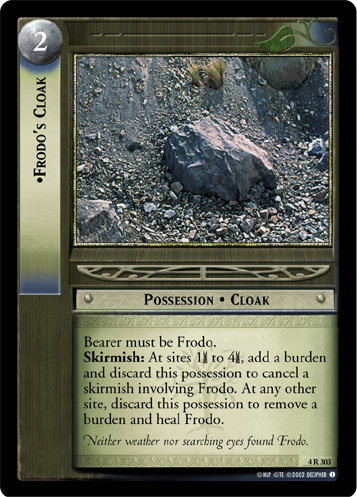 . By tapping into two of the game's largest resources - the Ring-bearer's resistance and vitality - Smeagol is able to reach previously unheard of strength levels at any time. Not Listening refunds the burdens added, triggering The Shire Countryside to remove up to 8 wounds from the Fellowship (plus another one on Smeagol from the event) and prime the Fellowship to do it all over again. In Movie Block it is further enabled by A Light in His Mind (10U108)
. By tapping into two of the game's largest resources - the Ring-bearer's resistance and vitality - Smeagol is able to reach previously unheard of strength levels at any time. Not Listening refunds the burdens added, triggering The Shire Countryside to remove up to 8 wounds from the Fellowship (plus another one on Smeagol from the event) and prime the Fellowship to do it all over again. In Movie Block it is further enabled by A Light in His Mind (10U108)
 and Nine-fingered Frodo and the Ring of Doom (10C112)
and Nine-fingered Frodo and the Ring of Doom (10C112)
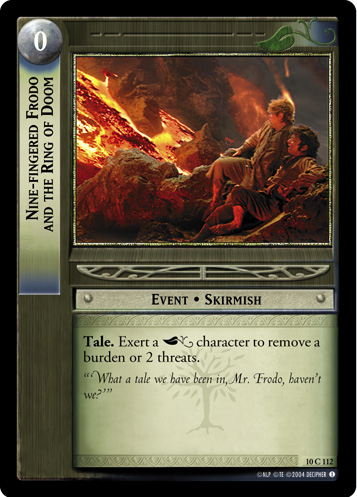 , with one or the other (occasionally even both) often seen with Birthday Present (10R104)
, with one or the other (occasionally even both) often seen with Birthday Present (10R104)
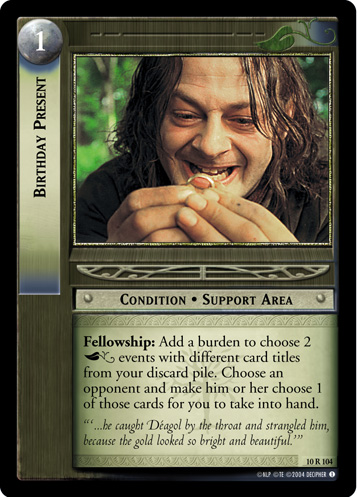 to churn out constant healing.
to churn out constant healing.
The greatest downside for The Shire Countryside is that it is often the only thing connecting the burden part of the deck to the rest of it. There will be some games when it is drawn later than one would like, and even more when it is discarded by a Shadow player before a player can get much use out of it. This makes The Shire Countryside both the cornerstone and the weak spot for a deck which is over-reliant on it, a dangerous combination: without it the Fellowship loses healing, of course, but they're also left to choose between not using the burden-adding portion of their strategy, conserving burden removal to take advantage of healing later (potentially allowing 5 burdens for Úlairë Enquëa, Lieutenant of Morgul (1U231)
 or clogging the hand), or using up their burden removal and not having enough left for healing down the road. The most consistent Shire Countryside decks, therefore, are aware that it may not always be available. Instead of forming the entire deck's identity, it is best used to compliment everything that the Free Peoples is already doing. Reliable and relatively costless burden removal from A Light in His Mind (10U108)
or clogging the hand), or using up their burden removal and not having enough left for healing down the road. The most consistent Shire Countryside decks, therefore, are aware that it may not always be available. Instead of forming the entire deck's identity, it is best used to compliment everything that the Free Peoples is already doing. Reliable and relatively costless burden removal from A Light in His Mind (10U108)
 goes far to mitigate these concerns, but of course it is an obvious target for removal as well and unique to boot.
goes far to mitigate these concerns, but of course it is an obvious target for removal as well and unique to boot.
While any deck with lots of burden removal is able to bid high, The Shire Countryside scales well as the game progresses and more copies are put in play. For some builds (particularly ones with a capacity for clearing minions off the table), it may be favorable to bid low and accept going second on occasion in hopes of passing the opponent later once everything is set up. Sanctuary healing can be unnecessary for Shire Countryside decks: doubling past the healing from site 6 is an act few others can follow and sets the stage for a double move to site 9 next turn for the win.
The King Block site path can be especially harrowing for The Shire Countryside. All site 4s allow the Shadow player to remove burdens, not only for great benefit but also denying an opportunity for the Free Peoples player to remove them and trigger healing. Pelennor Prairie (10U118)
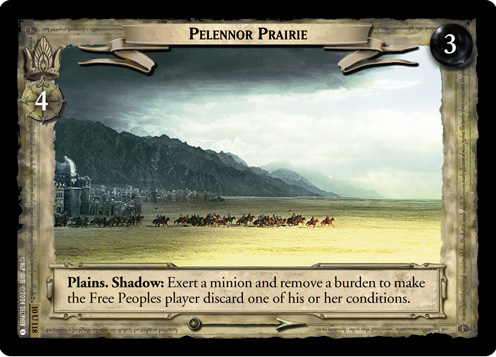 in particular demands that there be no burdens upon moving, which may be difficult at that point in the game. Anduin Banks (7U341)
in particular demands that there be no burdens upon moving, which may be difficult at that point in the game. Anduin Banks (7U341)
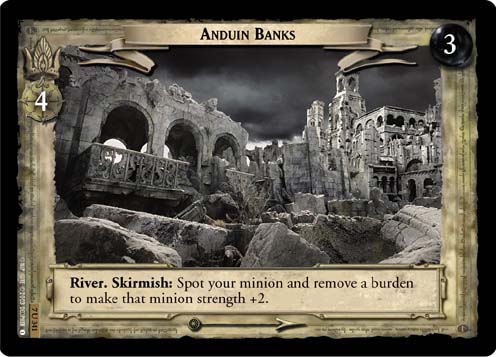 allows the Shadow player to make sure the Free Peoples player can't keep burdens on the board through usual means and may end up overwhelming companions. Steward's Tomb (10U119)
allows the Shadow player to make sure the Free Peoples player can't keep burdens on the board through usual means and may end up overwhelming companions. Steward's Tomb (10U119)
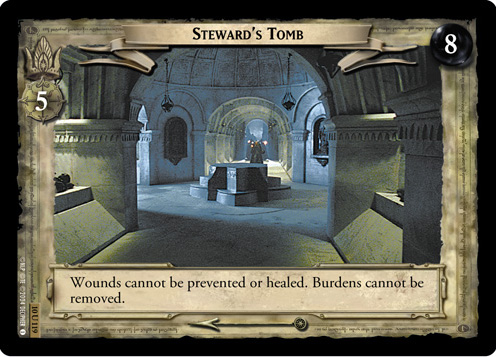 at the next site is even worse. Follow Sméagol (5U23)
at the next site is even worse. Follow Sméagol (5U23)
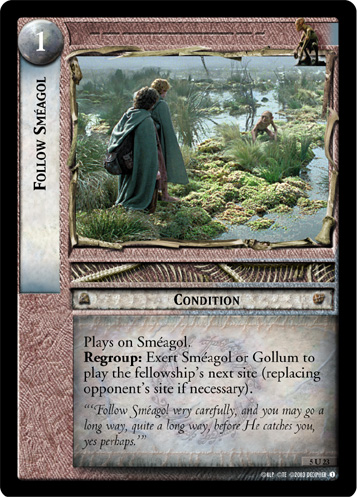 or Get On and Get Away (4R304)
or Get On and Get Away (4R304)
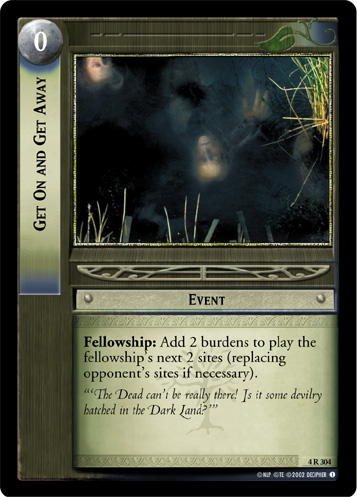 are natural fits, but there's no way to rely on drawing them by site 3. Rather than risk unfavorable sites it can be best to plan on going second, with Pelennor Plain (7U343)
are natural fits, but there's no way to rely on drawing them by site 3. Rather than risk unfavorable sites it can be best to plan on going second, with Pelennor Plain (7U343)
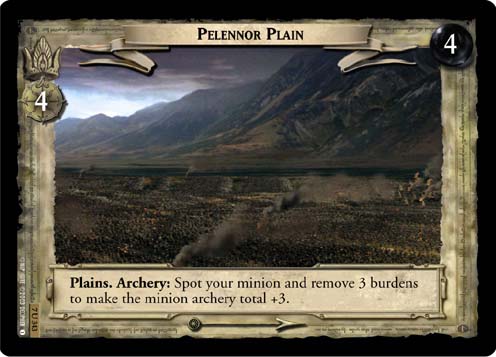 usually the safest site 4.
usually the safest site 4.
The "(except a Hobbit)" clause is carved out almost explicitly for Sam, Son of Hamfast (1C311)
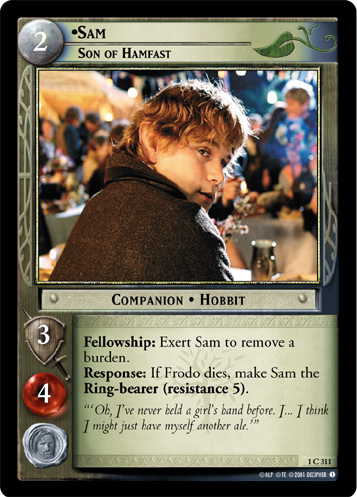 , though the two cards aren't always at odds. With some source of burden removal in the Fellowship phase, it can be shifted from a healing engine to a burden removal engine: remove burdens with Sam's text and then one more with a card like Brace of Coneys (4C298)
, though the two cards aren't always at odds. With some source of burden removal in the Fellowship phase, it can be shifted from a healing engine to a burden removal engine: remove burdens with Sam's text and then one more with a card like Brace of Coneys (4C298)
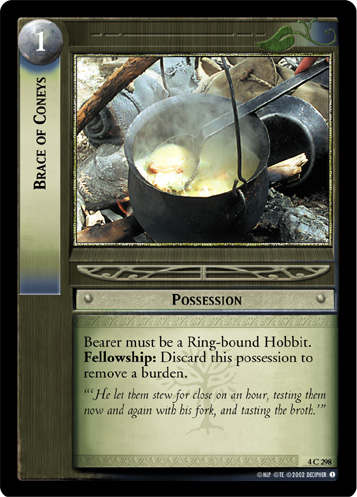 to trigger The Shire Countryside and heal Sam. This may be worth considering for a Free Peoples side which accumulates more burdens than wounds, though such strategies are few and far between.
to trigger The Shire Countryside and heal Sam. This may be worth considering for a Free Peoples side which accumulates more burdens than wounds, though such strategies are few and far between.
Deckbuilding Strategy[edit]
The cultural enforcement required by The Shire Countryside is weak for any deck with Frodo as the Ring-bearer. Playing a second Hobbit in the starting fellowship makes it much less likely to ever clog your hand, and having backup Hobbits in the deck provides some cover should you run into trouble early on. Merry, Friend to Sam (1R302)
 is a popular choice in the starting fellowship as his ability is naturally complemented by its healing, and
is a popular choice in the starting fellowship as his ability is naturally complemented by its healing, and remaining allows plenty of decks to take advantage of the setup.
The Shire Countryside enables some of the game's most potent and flexible healing, but it's not the only way to constantly remove wounds from companions. If there are many Frodo signets or a Gondor Man, Pipeweed decks provide a similar caliber of healing in the Fellowship phase without relying on conditions (though the reliance on possessions is a liability itself in Movie Block where corsairs and Corsair Marauder (8R57)
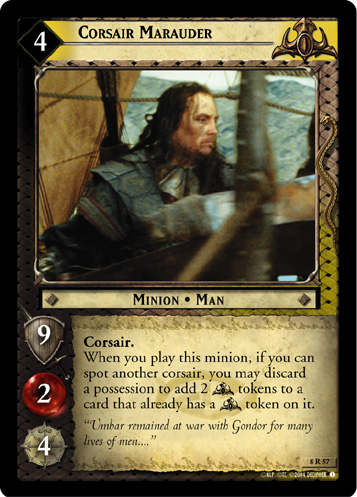 are popular). Shoulder to Shoulder (1C59)
are popular). Shoulder to Shoulder (1C59)
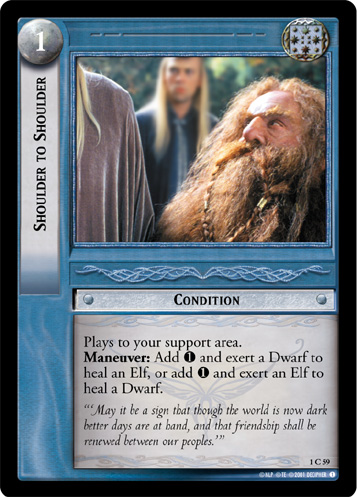 allows easy healing for Elven and Dwarf fellowships in the maneuver phase, transferring wounds to self-healing
allows easy healing for Elven and Dwarf fellowships in the maneuver phase, transferring wounds to self-healing Elven allies. The Hobbit Hospital strategy keeps Shire-folk healthy with Hobbit Party Guest (1C297)
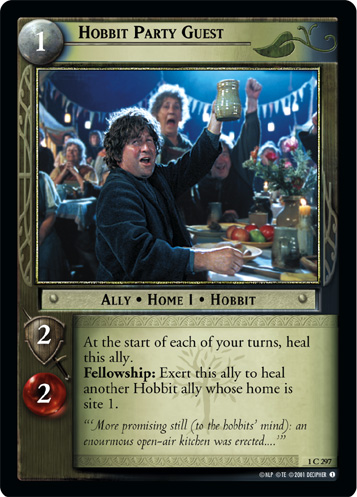 refilling The Gaffer, Sam's Father (1R291)
refilling The Gaffer, Sam's Father (1R291)
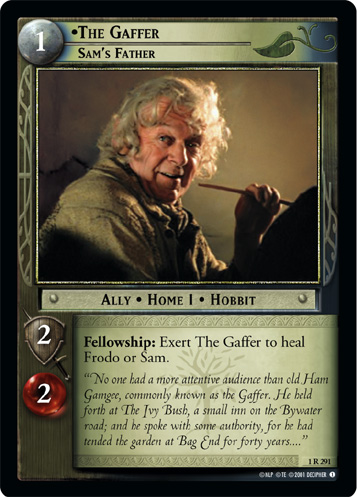 and Farmer Maggot, Chaser of Rascals (1R288)
and Farmer Maggot, Chaser of Rascals (1R288)
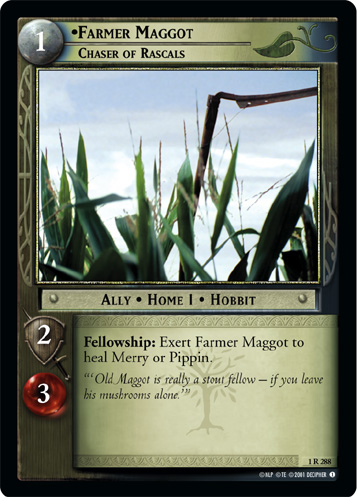 every turn.
every turn.
Strengths and Weaknesses[edit]
Synergizes With...[edit]
- Cards which stay on the table and can remove burdens essentially at will: Brace of Coneys (4C298)
 , A Light in His Mind (10U108)
, A Light in His Mind (10U108)
 , Frodo's Cloak (4R303)
, Frodo's Cloak (4R303)
 , Gandalf’s Pipe (1U74)
, Gandalf’s Pipe (1U74)

- Events which remove burdens, particularly in the middle of a turn where healing is harder to come by: Not Listening (6C43)
 and Nine-fingered Frodo and the Ring of Doom (10C112)
and Nine-fingered Frodo and the Ring of Doom (10C112)
 chief among them
chief among them - Cards which add burdens at will, to fuel the above: The One Ring, Answer To All Riddles (4R1)
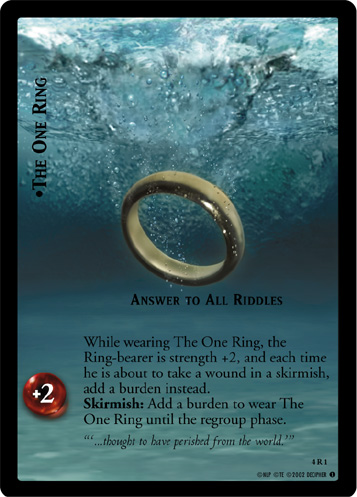 an obvious choice (though any version of The Ring other than The One Ring, The Ruling Ring (1C2)
an obvious choice (though any version of The Ring other than The One Ring, The Ruling Ring (1C2)
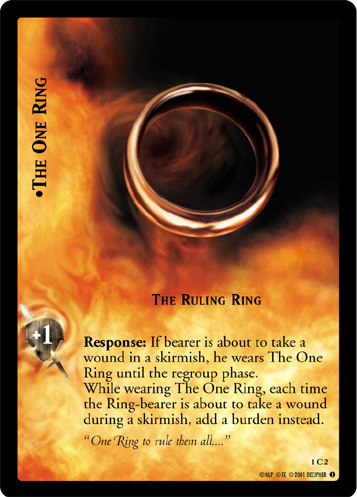 will often do the job), Birthday Present (10R104)
will often do the job), Birthday Present (10R104)
 , Frodo, Wicked Masster! (7R318)
, Frodo, Wicked Masster! (7R318)
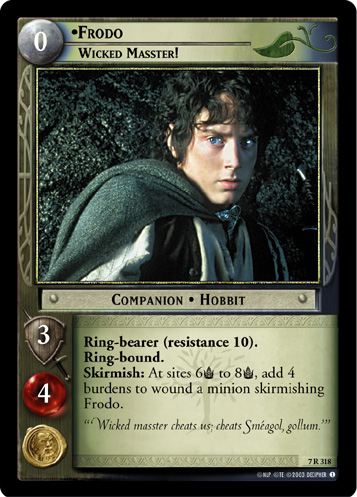 , Sméagol, Slinker (5R29)
, Sméagol, Slinker (5R29)

- Self-exerting companions: Boromir, Son of Denethor (1U97)
 , Merry, Friend to Sam (1R302)
, Merry, Friend to Sam (1R302)
 , Legolas, Greenleaf (1R50)
, Legolas, Greenleaf (1R50)
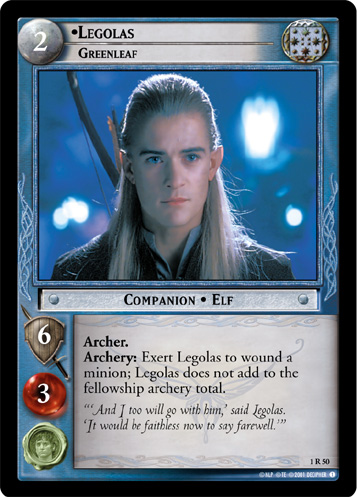
- Other reliable companion exertion sources: Sting, Baggins Heirloom (5R116)
 , Aragorn’s Bow (1R90)
, Aragorn’s Bow (1R90)
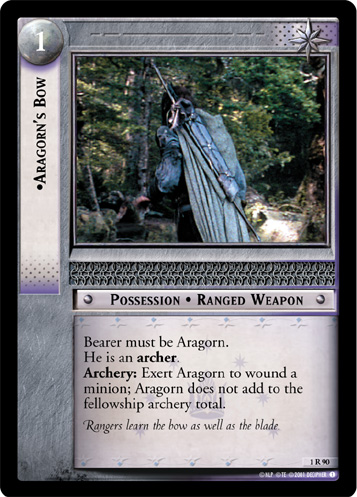 , Trust Me as You Once Did (3U35)
, Trust Me as You Once Did (3U35)
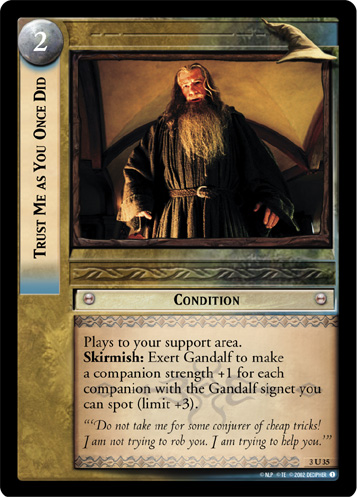
- Sam, Samwise the Brave (4C316)
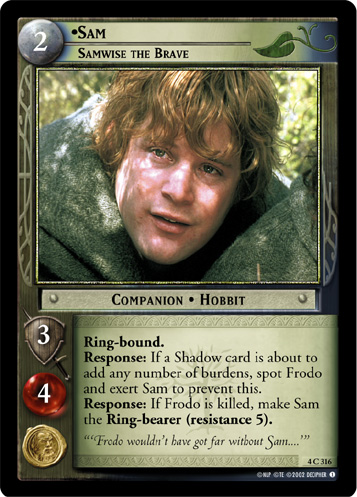 , to secure complete control over the number of burdens at all times
, to secure complete control over the number of burdens at all times - Cards like A Promise (2R112)
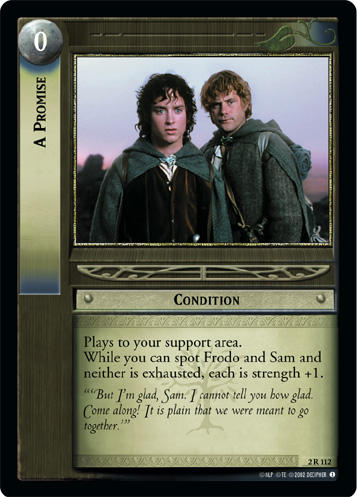 , which make it easy (and desirable) to keep Hobbits on the table
, which make it easy (and desirable) to keep Hobbits on the table
Strong Versus...[edit]
- Wounding strategies: Archery of every sort,
Sauron grind, Ring-bearer hate such as
Ringwraith Orcs, Promise Keeping (8R24)
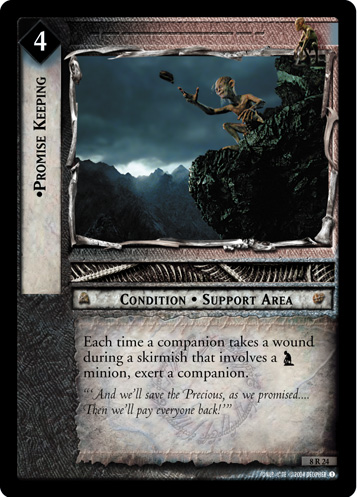
- Corruption, to varying degrees based on the makeup of the rest of the deck
- Certain beatdown decks, which may never be able to make wounds stick to the strongest companions
Weak Versus...[edit]
- Swarms, which rarely care about burdens or wounds (though Merry, Friend to Sam (1R302)
 and/or Boromir, Son of Denethor (1U97)
and/or Boromir, Son of Denethor (1U97)
 are natural fits which cover this weakness)
are natural fits which cover this weakness) - Multiple wounds applied all at once to kill companions: for example, losing a skirmish against a minion with a damage bonuses of 2+ or one in which Red Wrath (7U157)
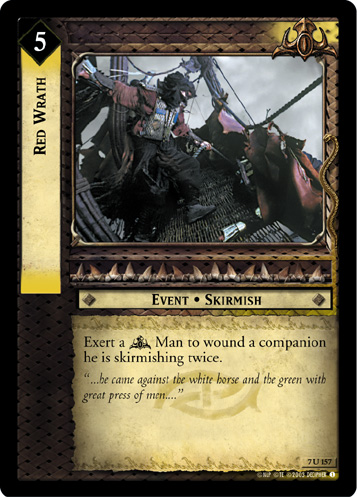 was played
was played - Beatdown decks that can overwhelm companions, especially
Sauron ones with Enduring Evil (1R246)
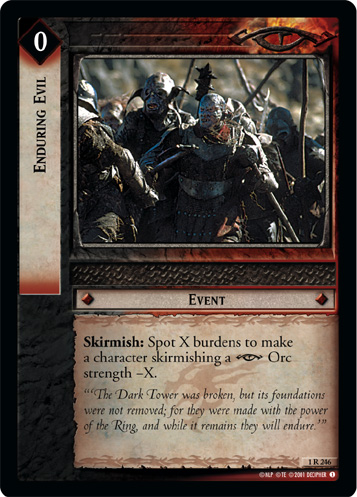
- Discovered (4R223)
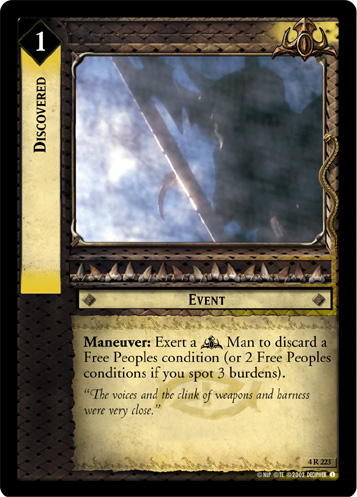
- Saruman's Power (1U136)
 , a potential danger in any
, a potential danger in any Isengard deck and sometimes splashed in wounding decks specifically for this card
Dunland: site liberation rarely is a natural fit in a Shire Countryside deck, and they can play Too Long Have These Peasants Stood (6U8)
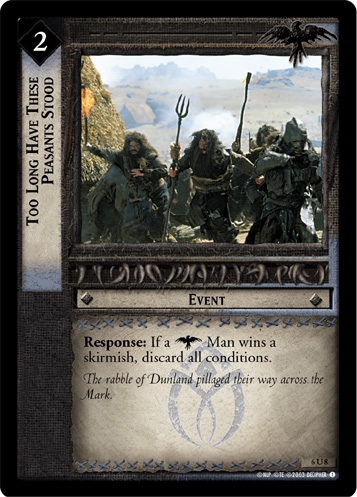 , overpower the Free Peoples with Dunlending Elder (6C2)
, overpower the Free Peoples with Dunlending Elder (6C2)
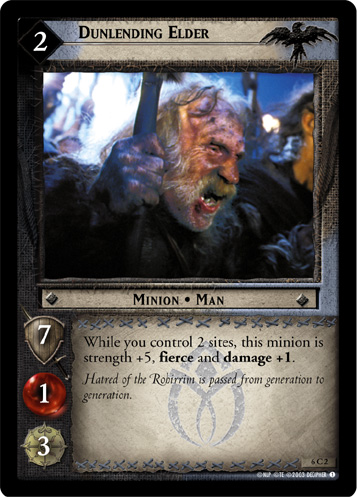 and Ready to Fall (6R7)
and Ready to Fall (6R7)
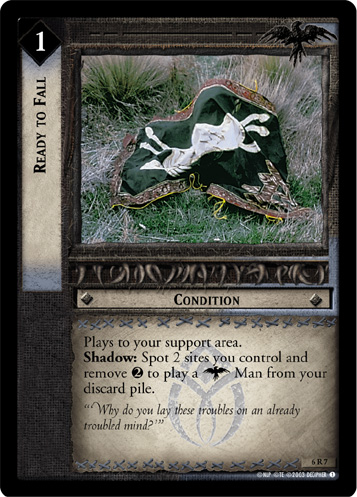 , or sidestep the Free Peoples strategy with Over the Isen (4U31)
, or sidestep the Free Peoples strategy with Over the Isen (4U31)
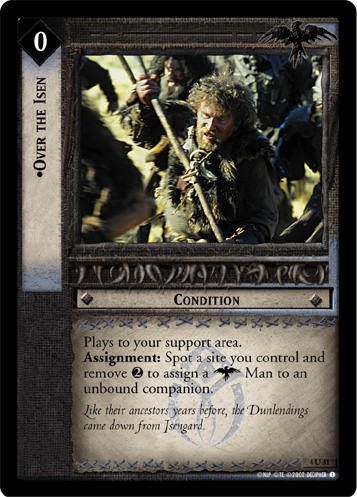
- Most site 4s on the King Block site path, especially Pelennor Prairie (10U118)
 which comes when the Free Peoples player may have a stockpile of burdens from earlier sites and little opportunity to remove them
which comes when the Free Peoples player may have a stockpile of burdens from earlier sites and little opportunity to remove them - Steward's Tomb (10U119)









